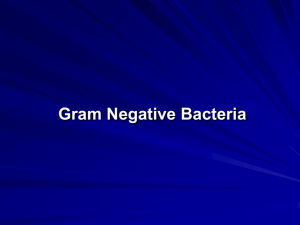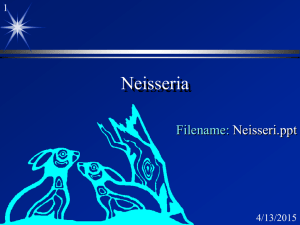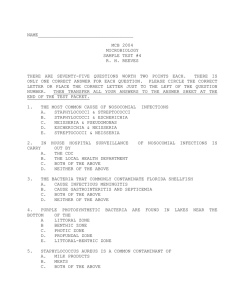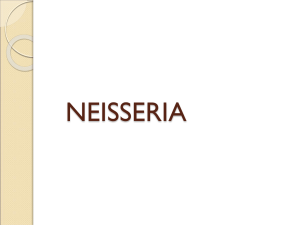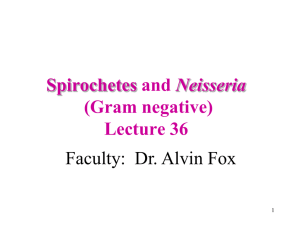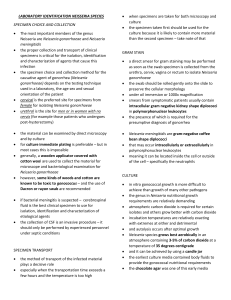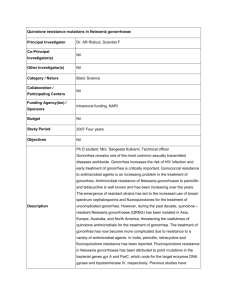Laboratory #5 - 16 Points
advertisement
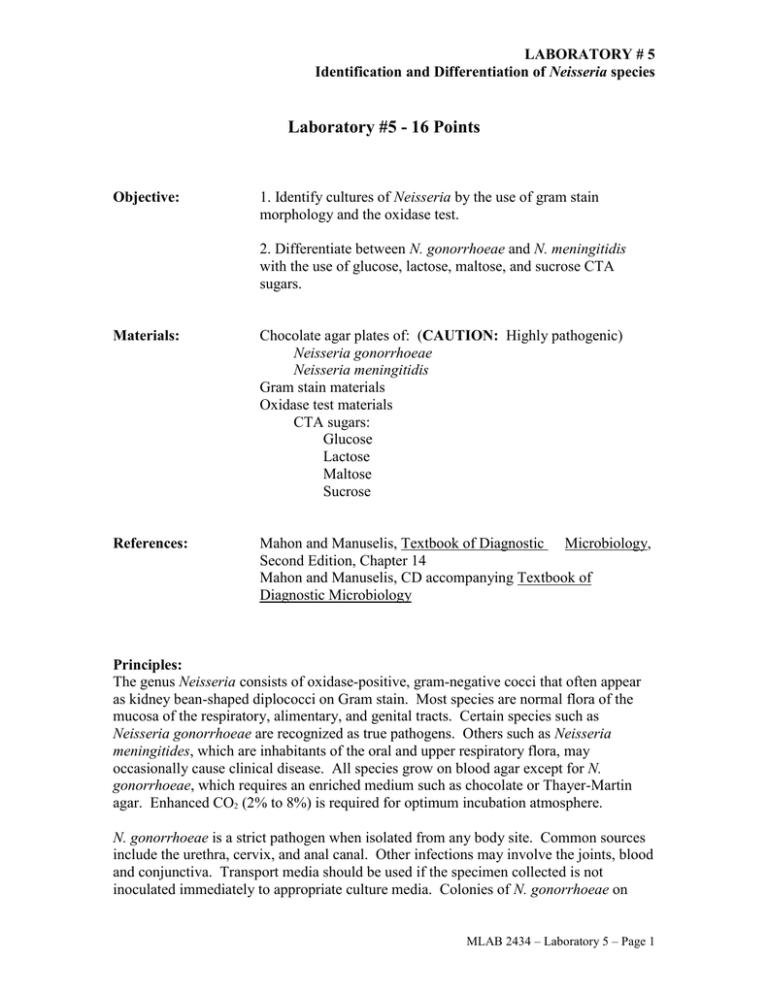
LABORATORY # 5 Identification and Differentiation of Neisseria species Laboratory #5 - 16 Points Objective: 1. Identify cultures of Neisseria by the use of gram stain morphology and the oxidase test. 2. Differentiate between N. gonorrhoeae and N. meningitidis with the use of glucose, lactose, maltose, and sucrose CTA sugars. Materials: Chocolate agar plates of: (CAUTION: Highly pathogenic) Neisseria gonorrhoeae Neisseria meningitidis Gram stain materials Oxidase test materials CTA sugars: Glucose Lactose Maltose Sucrose References: Mahon and Manuselis, Textbook of Diagnostic Microbiology, Second Edition, Chapter 14 Mahon and Manuselis, CD accompanying Textbook of Diagnostic Microbiology Principles: The genus Neisseria consists of oxidase-positive, gram-negative cocci that often appear as kidney bean-shaped diplococci on Gram stain. Most species are normal flora of the mucosa of the respiratory, alimentary, and genital tracts. Certain species such as Neisseria gonorrhoeae are recognized as true pathogens. Others such as Neisseria meningitides, which are inhabitants of the oral and upper respiratory flora, may occasionally cause clinical disease. All species grow on blood agar except for N. gonorrhoeae, which requires an enriched medium such as chocolate or Thayer-Martin agar. Enhanced CO2 (2% to 8%) is required for optimum incubation atmosphere. N. gonorrhoeae is a strict pathogen when isolated from any body site. Common sources include the urethra, cervix, and anal canal. Other infections may involve the joints, blood and conjunctiva. Transport media should be used if the specimen collected is not inoculated immediately to appropriate culture media. Colonies of N. gonorrhoeae on MLAB 2434 – Laboratory 5 – Page 1 LABORATORY # 5 Identification and Differentiation of Neisseria species chocolate agar appear small, translucent, grayish, convex and shiny with entire margins. Suspected colonies are tested for oxidase and a smear is made for Gram stain. Definitive identification is based on carbohydrate utilization or other rapid identification techniques such as latex agglutination. N. meningitides is carried as normal nasopharyngeal flora by a large percentage of the population. It is significant, however, when isolated from transtracheal aspirates, cerebrospinal fluid, or blood. In contrast to N. gonorrhoeae, N. meningitides is able to grow on blood agar as well as chocolate agar. The colonies appear small, gray, and convex. Presumptive identification is made based on finding oxidase-positive, gramnegative diplococci. Definitive identification is made by determining utilization of carbohydrates, latex agglutination test, or fluorescent antibody procedures. Moraxella catarrhalis is a member of the oral flora that has been recognized as an important agent of lower respiratory infections. Morphologically, these organisms resemble the Neisseria species. Definitive identification is based on carbohydrate utilization. The following chart shows the carbohydrate utilization reactions of Neisseria species. Species Tests/Results CTA Carbohydrates Maltose Lactose - Oxidase + Glucose + + + + - - N. lactamia + + + + - M. catarrhalis + - - - - N. gonorrhoeae N. meningitides Sucrose - Procedure: 1. Cultural and Cellular Morphology Observe the morphology of isolated colonies of N. gonorrhoeae and N. meningitidis and record on the chart at the end of this exercise. Gram stain each organism and record results. 2. Cytochrome Oxidase The cytochromes are iron-containing hemoproteins that act as the last link in the chain of aerobic respiration by transferring electrons (hydrogen) to oxygen, with the formation of water. The cytochrome system is possessed by aerobic or facultatively anaerobic organisms so that the oxidase test is important in identifying those organisms that either lack the enzyme or are obligate anaerobes. The cytochrome oxidase test utilizes certain reagent dyes, such as p-phenylenediamine MLAB 2434 – Laboratory 5 – Page 2 LABORATORY # 5 Identification and Differentiation of Neisseria species dihydrochloride, that substitute for oxygen as artificial electron acceptors. In the reduced state the dye is colorless; however, in the presence of cytochrome oxidase and atmospheric oxygen, p-phenylenediamine is oxidized, forming indophenol blue. The oxidase test must be performed on media without dye, since dye can interfere with color production. Oxidase testing will be demonstrated by the instructor. Use methods available and record results for each organism. 3. Carbohydrate Utilization with CTA Sugars Cystine trypticase agar (CTA) supports the growth of many fastidious organisms, including species of Neisseria. Various carbohydrates can be added to the CTA base for the purpose of testing for carbohydrate utilizations. Phenol red indicator is included in the medium and changes from red to yellow in the presence of acid, which is a waste product of carbohydrate utilization. a. Pre-warm and label tubes of CTA glucose, lactose, maltose, and sucrose for each organism. b. Gather several colonies from the plate with an inoculating loop and inoculate the upper portion of the medium heavily. c. d. Fasten the caps of the tubes loosely and incubate at least 24 hours. The development of a yellow band in the upper portion of the medium indicates production of acid and is interpreted as a positive test for utilization of the carbohydrate present. N. gonorrhoeae utilizes only glucose but N. meningitidis utilizes glucose and maltose with the production of acid. Record results. MLAB 2434 – Laboratory 5 – Page 3 LABORATORY # 5 Identification and Differentiation of Neisseria species Name ______________________________________________ Date _____________________________ Test/Procedure (1 pt. unless shown otherwise) Neisseria gonorrhoeae Colony Morphology (2 pts. Each) Gram stain Oxidase Glucose Lactose Maltose Sucrose Neisseria meningitidis MLAB 2434 – Laboratory 5 – Page 4
